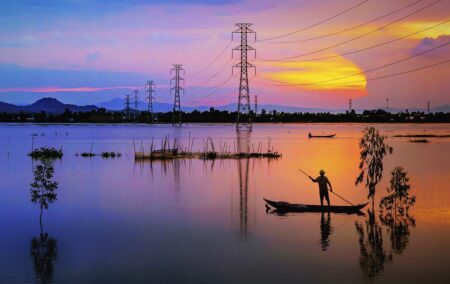Eskom and the government recently celebrated one-hundred-and-sixty days without loadshedding. With a more reliable electricity supply than in recent years − attributed to better and increased planned maintenance − the collective memory of loadshedding has faded from our minds. “What’s that?” some may be tempted to ask.
This is good news, not only for South Africans wanting to watch TV, cook, bathe and live their lives without interruption, but also for the economy and businesses that rely on a constant energy supply to produce goods, such as manufacturing, construction, the retail trade, and even tourist accommodation.
Eskom and the Government of National Unity (GNU) can now build on their electrifying success by removing other barriers, including the most pressing one; race-based procurement. The Zondo Commission has shown that this throws value-for-money out of the window (or down the smoke stack, if I may), in favour of cadre and crony-enriching BEE deals that rob ordinary South Africans of cheaper, reliable electricity.
Price going up
Eskom’s monopoly on the generation, transmission, and distribution of electricity, along with the costs that municipalities add, has pushed the price up eye-wateringly high. In Cape Town, I’ve paid R3.44/kWh most recently. The same time last year, the price was R3.09/kWh. That is an increase of 11%.
Eskom’s tariff has increased by 937% since 2007, while inflation increased 155% over the same period. The City of Cape Town has rightly opposed this assault on residents’ pockets, noting that the utility accounts for 70% of the municipality’s electricity costs. Passing these costs on to the consumer is unthinkably cruel, considering that millions are unemployed. They rely on social assistance from government and aresuffering through a cost-of-living crisis.
Municipal debt to Eskom
Municipalities are still failing to pay the energy utility. According to Eskom, municipal arrears (as of August 2024) stood at R82 billion “with an increase of approximately R15.9 billion in the last financial year”. That figure has never decreased: In 2022, the debt stood at R50 billion. A year later it increased to R63.2 billion.
The Minister of Electricity, Dr Kgosientsho Ramakgopa, said that the following are core issues that need to be solved by municipalities:
- Failure to ring-fence electricity provision,
- Failing revenue management,
- Failing infrastructure and lacking investment, and
- Vandalism, losses and theft.
In addition, all 257 municipalities are obliged to provide Free Basic Electricity (FBE).
“Free basic electricity of 50kWh per household per month for a grid-energy system (connected through the national electrification programme) is provided. This amount of electricity will be enough to provide basic lighting, basic water heating using a kettle, basic ironing and a small black and white TV and radio,” according to the government.
Unable to work, residents are overly reliant on “free” basic services from government.
Municipalities use ratepayers’ money to subsidise indigent households.
A low revenue collection rate directly impacts service delivery. For example, in early 2022 the City of Tshwane’s average collection rate was R2.5 billion/month. By September, it had increased to R3 billion, with the capital city saying: “Meeting [our R4 billion] target will enable the city to gather enough cash resources to pay service providers like Eskom on time.”
Service delivery is the core mandate of municipal government. This includes the provision of electricity. Eskom recently attached the bank accounts of the mismanaged Emfuleni (Vereeniging) Municipality because it failed to arrange a payment plan for its R8 billion debt; roughly 10% of total debt owed to Eskom by municipalities.
Communities – having been deprived of reliable, affordable electricity – have now demonstrated and established South Africa’s right to electricity.
This has created somewhat of a conundrum, because the President argued – in the UDM and BOSA’s loadshedding court case – that “none of the government respondents (which include Eskom and its shareholder representative, then-Minister of Public Enterprises) have a constitutional responsibility to supply electricity to the people of the Republic”.
This was the entire reason for Eskom when the Union government established it through the Electricity Act of 1922:
“It will be our endeavour to play our part not as those who follow where others lead, but as pioneers; to foresee the needs of a country fast developing, and by wise anticipation be ever ready to provide power…wherever it may be required,” said Eskom’s first chairman, Dr Hendrik van der Bijl (ironically, Vanderbijlpark, which falls under the above-named Emfuleni municipality, was named after him).
Economic growth
The only way to provide reliable electricity for all South Africans, improve revenue collection, reduce Eskom debt, and ensure that residents pay their bills is to implement pro-growth policies that will get South Africans into jobs. The IRR’s Growth Strategy provides the roadmap: increasing investment by scrapping the threat to property rights; maintaining and expanding infrastructure, reforming restrictive labour legislation, and scrapping race-based affirmative action policy in favour of the IRR’s non-racial Economic Empowerment for the Disadvantaged (EED).
The #WhatSACanBe solution proposes that the GNU open the energy market to promote competition with Eskom in an effort to lower prices for consumers. With 90% of electricity being generated by Eskom and the price of electricity rocketing, South Africans deserve reliable, affordable electricity. Relieving Eskom of its debt by privatising its transmission division is one way of doing that, among other measures. The Government of National Unity can help the economy by implementing these key reforms.
The IRR paper can be read here.
If you like what you have just read, support the Daily Friend
Image by Văn Long Bùi from Pixabay

